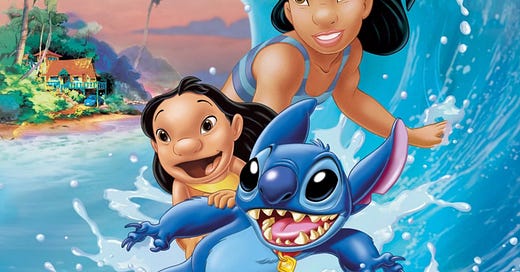For the Freaks: Lilo & Stitch
All the protagonists are ugly ducklings. They’re out of place, unusual, and unwanted and not necessarily because of anything they’ve done but because of who they are.
Grade: A+
Hans Christian Anderson walked into Steven Spielberg’s office at Amblin in 1983. He told Spielberg he loved ET and had a great idea for his next film. Spielberg listened and loved Anderson’s story about a duckling who is rejected by everyone but finally finds where he belongs, but he then asked if Andersson would mind if they made the duckling a monstrous alien. Will that work? Anderson asked.
This never really happened. Lilo & Stitch was created by Chris Sanders and Dean DeBlois in 2002 at the tail end of the Disney Renaissance. During the 90s, Disney revived itself by returning to the company’s roots as they were planted by Walt Disney fifty years before: turning old and oft-told tales into animated films. A French fable about a Beauty and a Beast, Aladdin from the Arabian Nights, and even a warrior woman of Chinese folk lore were beamed up onto the cinema screen. Disney returned to adapting “tale[s] as old as time.” Lilo & Stitch may have looked like a departure from this. The film was not obviously derived from any fairytale, popular story or folklore. It instead looked like something from a sci-fi novel. An alien crash lands on Earth. He’s pursued by the mad scientist who created him, mistaken for a dog and adopted by a young girl named Lilo. She names him “Stitch.” Yet if you look closer, peel back the sci-fi surface, you can see a story that, like Aladdin, Mulan and Beauty and the Beast, is told again and again.
One night, Stitch takes a book from Lilo’s bookshelf and finds a picture of a duckling alone and weeping. “That’s the ugly duckling,” Lilo tells him. Lilo & Stitch is Han Christian Anderson’s 19th century fairytale “The Ugly Duckling” translated into a modern-day sci-fi adventure.
It’s a story of freaks, misfits and outcast. Stitch is branded a “monstrosity” by the Galactic Council and sentenced to exile. Everyone tells him that he is a monster who can only destroy. “You can never belong,” his creator Jumba tells him, as Stitch stands alone in the forest, waiting for a family to find him, as the Ugly Duckling’s family does in Anderson’s fairytale. Lilo too is a freak. Her hobbies include voodoo, taking pictures of obese tourists and feeding peanut butter sandwiches to fish who she says control the weather. When her classmates call her crazy, she turns feral and bites them, like a young Tarzan tossed into a modern-day classroom. Even if that is out of order, when she asks to play dolls with them and they leave her alone because her hand-made doll is ugly, you’ll still feel like crying for her. “They treat me different,” she says sadly.
An accident has left her and her older sister Nani without their parents, and Nani is struggling to be a full-time parent to Lilo with social workers breathing down her neck. She has a continuously harassed manner. You can see she’s on the verge of ripping her hair out as she tries to navigate her less than normal family dynamic. Even Jumba and Agent Pleakley, the Earth expert the Galactic Council sends with Jumba to capture Stitch, are out of place, both on Earth and even amongst their fellow aliens. The other aliens are severe, dinosaur-looking creatures. Jumba and Pleakley are not. Jumba is a rotund, six-eyed Dr Frankenstein and falls over himself laughing a maniacal belly laugh when talking about how he created Stitch to have no instinct except “to destroy everything he touches.” He takes such ludicrous joy in contemplating mass destruction that he’s funny rather than scary. Pleakley has a balloon-like head, a body as thin and floppy as noodles, and has a habit of flapping his hands about when he speaks while his voice jumps up and down several octaves. Compared to the other aliens, he looks like the school nerd standing amongst the school football team and prefects. He and Jumba make an extraterrestrial Laurel and Hardy, while their superiors tell them that their “incompetence is nothing short of unspeakable.”
All the protagonists are ugly ducklings. They’re out of place, unusual, and unwanted and not necessarily because of anything they’ve done but because of who they are. It’s like there’s something about them all that they can’t change and that means they’ll forever be alone. That is, until they all find each other. In the end, like the Ugly Ducking, they find somewhere they can belong together. Lilo & Stitch is a film for the freaks. If a genetically-engineered monster from outer space can find their place, so can you.




